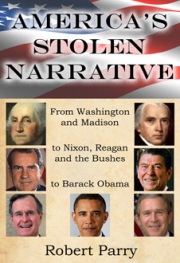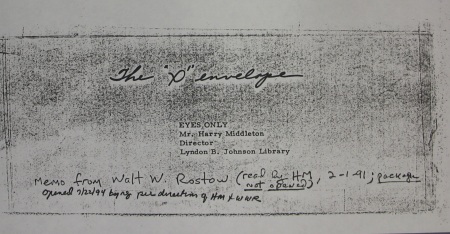“Nixon Camp Sabotages Viet Peace Talks” — Had the story under that headline been published in real time, Richard Nixon might have lost the 1968 election, and the Vietnam War would likely have ended years earlier. Now, with Robert Parry‘s latest book, “America’s Stolen Narrative,” a full telling of that story has been published, and a sketchy part of America’s history can be filled. The book gives up-to-date, factual, solidly-sourced stories of several important recent (and a few of the earliest) events of American history. And it points out the false narratives, as it sweeps them away. Here are some of the highlights:
- Nixon’s Vietnam Peace Sabotage: “Huh, no. My God, I would never do anything to encourage … Saigon not to come to the table,” said Nixon to President Lyndon Johnson. Late in the 1968 presidential election season, Johnson was close to getting both North and South Vietnam to meet for peace talks in Paris. Such progress towards peace could have given a boost to Vice President Hubert Humphrey over Nixon in the presidential race. But someone from the Nixon camp felt sure it had the peace talks blocked, and sent that inside dope to some Wall Street banker buddies. Johnson caught wind of that, and ordered wiretaps. Soon, he got proof that the Nixon camp was urging South Vietnam to stay away from the peace talks, and offering a “better deal” should Nixon become president. When Johnson sent word that he might go public with the proof, “Tricky Dicky” Nixon phoned to try to fool Johnson with the lie quoted above. The Christian Science Monitor had also caught wind of Nixon’s sabotage, and, before running the story, sought confirmation from the administration. But Johnson decided, “for the good of the country,” not to go public. And, as it happened, the government of South Vietnam did stay away from the peace talks, Nixon won a close election, and the killing went on for four more years. And so began a recurring pattern where high Republican officials would do dirty deeds, some treasonous, some criminal, and high Democratic officials would cover them up.
- The Road to Watergate: “Godammit, get in and get those files. Blow the safe and get it,” said Nixon to his staff members, H.R. Haldeman and Henry Kissinger. In June 1971, Nixon gave that command to break-in to the Brookings Institution, most likely to get the file with Johnson’s proof of Nixon’s treasonous peace talk sabotage – a file that could scuttle his re-election. And so we see, a year before their Watergate break-ins, the beginnings of Nixon’s band of criminals known as the “Plumbers.” But, before he left office, Johnson gave the file to his adviser Walt Rostow, and so kept it away from Nixon. In 1973, after Johnson’s death, and as Nixon’s presidency began to crumble from the Watergate scandal, Rostow sent the file, which he labeled “the X envelope,” to the LBJ Library. He thought the contents to be such a blot on the U.S.A., that he wrote an instruction to keep it sealed for 50 years, at which time the library’s director could open it, and decide to seal it for another 50 years. But in 1994, “just” 21 years later, Rostow and the library’s director decided to open the file, and today it is largely declassified.
- October Surprise: The movie “Raiders of the Lost Ark” portrayed a vast underground government archive warehouse, where the powerful Ark of the Covenant was to be stashed for all time. That is how Lawrence Barcella, chief counsel of the House’s October Surprise Task Force, imagined the place where he had sent the Russian Report on the plot. The report came from old Soviet intelligence files, and was sent by the Russian parliament, to answer a request from the task force. But Robert Parry got a pass to the archive warehouse and copied the Russian Report, and other documents, from the boxes of task force materials he found there. The documents backed reports of some 24 witnesses to the deal between presidential candidate Ronald Reagan’s camp and Iranian leader Ayatollah Ruhollah Khomeini’s faction. The deal went through: the Iranians, who had been holding 52 Americans hostage for nearly a year, delayed their release until Reagan took office, and the Reagan people sent arms to Iran. The Russian Report confirmed that Ronald Reagan’s campaign chief William Casey, Reagan’s running mate George H.W. Bush, and CIA officer Robert Gates were among those who met with Iranians in 1980. Like the treasonous Nixon, Reagan became president helped by his camp’s sabotage of negotiations by the sitting president, Jimmy Carter in this case. Unlike Nixon’s Vietnam peace talk sabotage, the October Surprise plot got a Congressional investigation, spurred in part by Robert Parry’s reporting for PBS’s “Frontline.” And though Barcella asked for a three-month extension to study other new evidence flowing in, the committee, led by Lee Hamilton (D – IN), rushed to wrap up the investigation, skipping the Russian Report, making up alibis, and clearing the Republicans due to “no credible evidence.”
The book also tells the stories of:
- how the government of Israel helped the Reagan crew set up the October Surprise plot and the arms pipeline through Israel to Iran, which likely continued into the Iran-Contra scandal.
- how the Bush I White House foiled the October Surprise and Iran-Contra investigations with a program of media pressure, arm-twisting, subpoena-dodging, and delay, while raising a stink about the cost of the probes.
- how alibis for high-level Republicans, such as George H. W. Bush and William Casey in October Surprise, and Robert Gates in Iraqgate, dissolved after a little investigation.
- how two ladder-climbers, Colin Powell and Robert Gates, by doing dirty deeds and cover-ups for their bosses, rose to the highest levels of government, while being toasted by the Washington Establishment.
- how the American Right tries to revise history with its ideas of constitutionality that are more in line with the Articles of Confederation than with the Constitution, whose authors aimed for a strong, pragmatic central government under sovereignty of “We the People.”
A nice feature of the book is that many of its notes have web links to original documents and recordings. For example, here is a link that shows the sign-in sheet that helped dismantle Robert Gates’ alibi that he was at a White House meeting with the prime minister of Belize and not at an Iraqgate meeting with an Israeli intelligence agent on April 20, 1989. And here is a link where you can hear the phone call noted above, where Nixon lies to Johnson about sabotaging the Vietnam peace talks.
The book’s author, Robert Parry, wrote some of the earliest stories of Iran-Contra and October Surprise. He has followed up on these and other such stories, digging up and keeping up on new evidence along the way. “America’s Stolen Narrative” is the latest, and, I think, the greatest, result of that work. It is not a long book — 221 pages not counting the index and notes – but it is a meaty book. Virtually every word in it advances the stories told. And they are the classic product of investigative reporting – exposés of dirty, anti-democratic deeds by the highest officers of the republic, a type of story crucial to an informed citizenry in a democracy. These stories show that some conspiracies really are true. But, as the author points out, it is only “careful research and open-minded reporting” that can separate what is real from what is “just a curious anomaly or something hard to explain.” While these stories were largely missed in real time, they are here now, and should rightfully become well-known American history. You the reader can help that come to pass.
To buy “America’s Stolen Narrative”:
- Paperback from Robert Parry’s site, Consortiumnews.com
- Paperback from Amazon.com
- e-Book for Nook from Barnes & Noble
- e-Book for Kindle from Amazon.com
I have several copies of Robert Parry’s prior book, “Neck Deep – The Disastrous Presidency of George W. Bush” to give away. E-mail me your (U.S.) mailing address, and I will, while they last, send one to you postpaid. (Note: The free books are now gone.)
Sources
America’s Stolen Narrative “America’s Stolen Narrative — From Washington and Madison to Nixon, Reagan and the Bushes to Barack Obama” by Robert Parry
here is a link “America’s Stolen Narrative” Note #152: Sign-in sheet for White House meeting with prime minister of Belize, 1989-04-20.
here is a link Nixon’s phone call to LBJ, 1968-11-03 – LBJ Presidential Library. Referenced from “America’s Stolen Narrative” Note #28
* * *
By Quinn Hungeski, TheParagraph.com, Copyright (CC BY-ND) 2013


